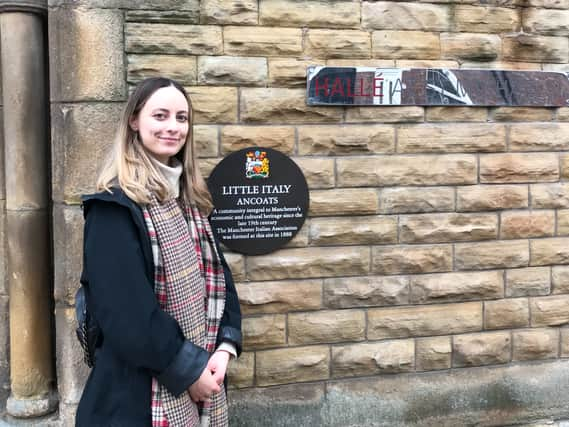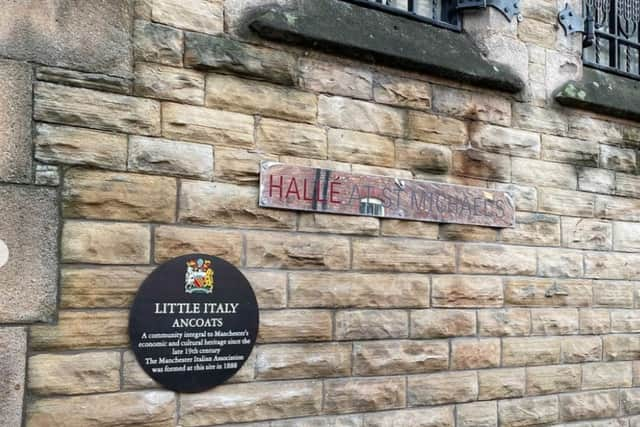Manchester’s very own Little Italy marked - thanks to famous ice cream seller’s grand-daughter
This article contains affiliate links. We may earn a small commission on items purchased through this article, but that does not affect our editorial judgement.


The Italian community which once lived in the Manchester neighbourhood of Ancoats has been remembered with a new plaque.
The smart metal disc on the wall of Halle at St Michael’s on George Leigh Street recognises the area as “Little Italy Ancoats” and pays tribute to: “A community integral to Manchester’s economic and cultural heritage since the late 19th century”.
Advertisement
Hide AdAdvertisement
Hide AdThe driving force behind the campaign to recognise Italians’ contributions to the city was public health employee Lily Mott, whose grandparents ran one of the famous ice cream businesses that were in the area.
Lily said it was also nice to recognise Ancoats’ past as the area undergoes vast changes thanks to the huge amounts of regeneration and investment there in the past few years.
Why was the plaque installed?
Lily began campaigning for a plaque recognising the Italian contribution to Ancoats in February 2020 and it was recently installed some 22 months later after meetings and discussions with the authorities and fund-raising efforts.
It has been installed on the wall of the former St Michael’s RC Church, which was built in the mid-1800s and played a key role at the heart of life in Manchester’s Little Italy.
Advertisement
Hide AdAdvertisement
Hide AdThere was also a school on the street attended by many children of Italian immigrants.
Lily, who is currently studying for a Master’s in public health and lives in Prestwich, explained that the Italian connection to Ancoats is also a personal story for her.
Lily, 24, said: “My family has Italian heritage and my grandma and grandad ran the ice cream business Granelli’s.
“This is personal to me, it’s my own family history. It means a lot for that to be recognised.
Advertisement
Hide AdAdvertisement
Hide Ad“I just realised there wasn’t any official commemoration or recognition of the fact Ancoats was Little Italy.
“I started thinking what we could do to make it official and realised Manchester Art Gallery runs a commemorative plaque scheme and you can get plaques for people, places or events.


“I got an application and after many obstacles we got there in the end.”
Lily says she would now like to see a big public unveiling and celebration of the plaque next year bringing together the community and Italian food and drink businesses in Manchester.
Advertisement
Hide AdAdvertisement
Hide AdThe plaque also pays tribute to the Manchester Italian Association, which was founded in 1888 as the Manchester Italian Catholic Society and continues to represent the community today.
Why did Ancoats become Manchester’s Little Italy?
Anthony Rea’s website Ancoats Little Italy has recorded the history of the community and the area.
The greatest influx came in the second half of the 19th century when thousands of people left behind their lives in Italy’s rural villages and settled in Ancoats.
One of the industries they became particularly known for was the ice cream business, and at one point competition between the major families became so intense it became known as the Ice Cream Wars.
Advertisement
Hide AdAdvertisement
Hide AdIndeed, the British ice cream industry has its origins in Little Italies around the country.
The Italian community also brought their music, food and customs to the Ancoats area.
The community in Little Italy came to an end in the second half of the 20th century when the council decided on a policy of slum clearances as heavy industries declined and residents were moved out to other parts of Manchester.
What has Lily said about the plaque?
Lily said it was important to remember the past in Ancoats as the area has changed enormously over the last few years as money has been ploughed into new buildings and businesses there.
Advertisement
Hide AdAdvertisement
Hide AdThe neighbourhood has become an up-and-coming hotspot of Manchester and made a global survey of the coolest places to live on the planet.
She also said that, given some of the headlines around immigration, it was good to be able to recall and tell a positive story of the huge contribution made by people who came to Britain to start a new life.


She said: “Ancoats has had so much investment and regeneration in the past few years but I don’t want people to move in and not know the history of the area.
“It’s also a really positive story about immigration, especially with the climate we are in today.
Advertisement
Hide AdAdvertisement
Hide Ad“Manchester is a really welcoming place which is built on immigration. There are so many different communities here in Manchester and that brings with it cultural significance.
“That has made it the city it is today.”
Comment Guidelines
National World encourages reader discussion on our stories. User feedback, insights and back-and-forth exchanges add a rich layer of context to reporting. Please review our Community Guidelines before commenting.
